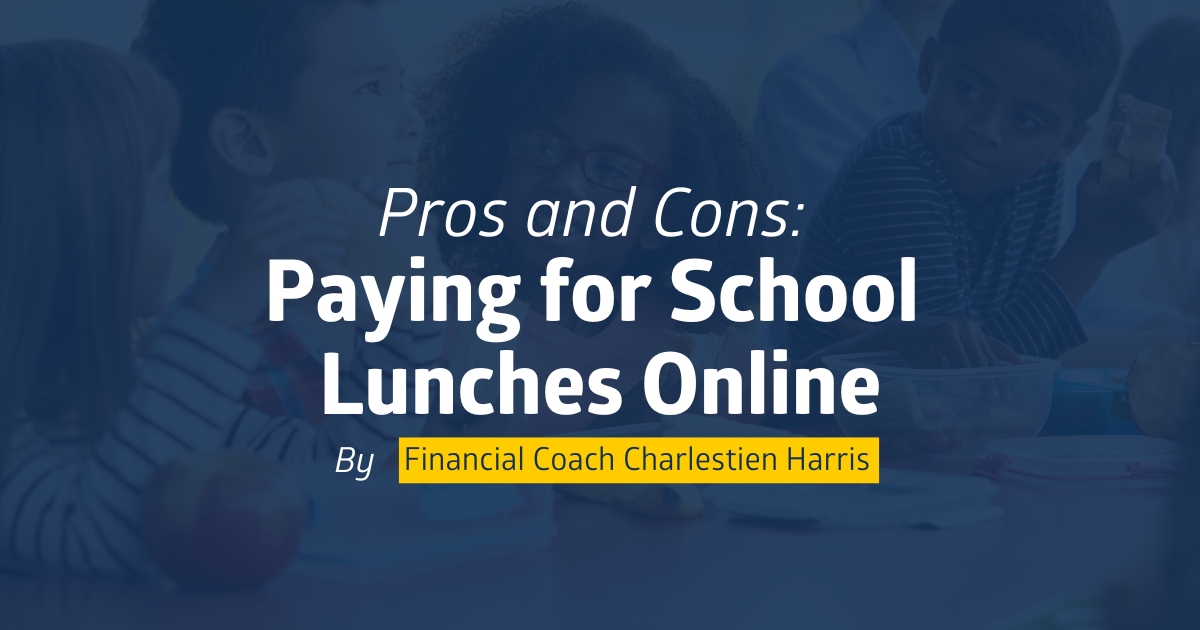By Charlestien Harris
Over 95,000 schools and institutions serve lunches to 28.6 million students each day, including 19 million free lunches, 1.1 million at reduced price, and 8.5 million at full price. Nearly 4.7 billion lunches are served annually, according to USDA data collected in 2023. Most of these meals are funded by taxpayer dollars, but some parents are responsible for covering the cost of their children’s school meals. One payment option that has gained popularity is paying for school lunches online. I found this option interesting, so I decided to explore the benefits of not having to pay cash daily, as well as some drawbacks of using this payment method. Here’s what I discovered.
PROS
- Flexibility in Payment Options
Parents can pay with cash, check, or credit card. Depending on when a parent gets paid, it can be challenging to consistently provide money when a child needs to pay for their meal daily. Knowing that the meal is already paid for, with the option of installment payments, can provide peace of mind. - Access to Menus and Preordering
Parents can view the menu, preorder, and prepay online. Children often complain about the food choices they have at school. Being able to see the menu, make choices, and decide when to pack your child’s lunch instead of paying for a meal they might not eat can be a big plus. - Email Alerts for Low Balances
Parents can receive email alerts when the school lunch software detects a low balance. This feature is convenient, as it helps avoid negative balances by allowing parents to set up automatic payments within the account established in their or their child’s name. - More Time for Teachers to Teach
Teachers often handle the collection of money for school lunches. Many appreciate the new online system because it gives them more time to prepare for instruction and reduces the amount of paperwork and money-handling they need to do.
CONS
- Fees for Using the Online System
As with many conveniences, there is usually a cost involved. A report from the CFPB found that fees for online payment processors used by schools range from $1 to $3.25 per transaction, with percentage fees ranging from 3.5 to 4.58 percent per deposit. These fees can be incurred a few times a year or as frequently as twice a month. - Fees for Creating an Account
In addition to transaction fees, parents may be charged a small program fee when they open an account or a convenience fee to transfer funds between their children’s accounts. These additional fees can create a financial strain, especially on tight budgets, and may lead to a lapse in food services for the children involved. - Varying Fees Based on Lunch Option
The CFPB report found that families who pay full price for lunches might incur transaction fees of 8 cents per dollar spent. However, lower-income families who qualify for reduced-price lunches could be charged up to 60 cents per dollar spent. Based on CFPB data, these families pay roughly $72 a year for 180 days of lunches, plus $42 in fees when making two deposits a month into their child’s account. Flat fees, which were more widely used among the school districts the CFPB examined, can be particularly costly for lower-income families, who tend to make smaller, more frequent deposits. - High Cost of “Junk” Fees
Transaction fees and other “junk” fees can place a significant economic burden on American families trying to manage basic school expenses on a budget. The fees parents pay to make online deposits into their children’s school lunch accounts are under scrutiny by the Consumer Financial Protection Bureau, which found that some low- to moderate-income parents may pay up to 60 cents in fees for every dollar they deposit. These fees can amount to tens of millions of dollars for payment processors.
Before signing up for an online payment program, do your homework. Determine whether enrolling in this program will actually save you money. The CFPB estimates that payment processors collect between $28 million and $92 million in fees from families paying full fare for lunch, and between $1.9 million and $10.2 million from those paying reduced prices. If you can manage to pay with cash, you won’t incur extra program or service fees, which can be a plus! Ultimately, only you, as a parent, can decide which option is best for you, based on how your money flows through your household.
For more information on this and other financial topics, visit www.banksouthern.com/blog. You can also email me at Charlestien.Harris@banksouthern.com or call me at 662-624-5776.
Until next week – stay financially fit!
